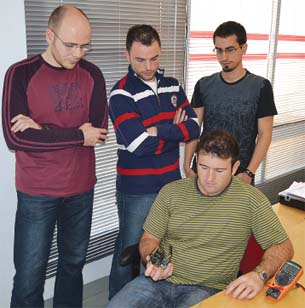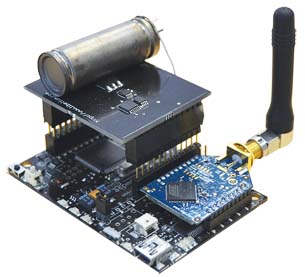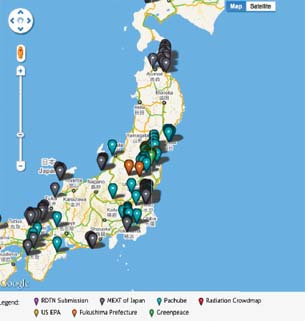Sensors Monitor Radiation in Japan
Engineers give data to the people.
Latest News
May 1, 2011
By Mark Boyd
 Some of the radiation sensor engineering team members look over their handiwork. |
Following the devastating earthquake in Japan this year and its dangerous impact on nuclear power plants in Fukushima, a network of engineers has banded together to create wireless radiation sensors for the Japanese community. But limitations to radiation sensor technology and stockpiling of key components in other nations threatens to stall opportunities to help. Spanish wireless sensor manufacturer, Libelium, is working on a low-cost solution.
On March 11 this year, an earthquake decimated areas of northern Japan. This, and subsequent aftershocks, caused disturbances at nuclear power plants in the Japanese city of Fukushima, requiring the evacuation of more than 150,000 residents living within a 20-mile radius of the nuclear power sites. Thousands more — including a large organic farming community — still live in relative proximity to the nuclear sites.
For many living in surrounding areas, a key concern now is to monitor radiation levels to ensure ongoing safety. Radiation risk is measured by a number of parameters and can be quite complex, but in general data is usually recorded in terms of microsieverts per hour (µSv/H), which reflects the level of radiation in the atmosphere and how much energy a human body absorbs from it. Background radiation levels generally fall around the 0.03 µSv/H range, with any readings above 0.081 µSv/H representing an above average result. Fukushima was registering as high as 80 µSv/H in the days immediately following the disaster, with levels at the start of April of around 10 µSv/H.
For local citizens, the lack of available, trustworthy information on current radiation levels has been a cause of anxiety and fear. According to the Bulletin of Atomic Scientists, TEPCO — the corporation that manages the Fukushima power plants — has been accused of falsifying data in the past, and in this recent disaster has been reprimanded more than once for inadequate data collection processes.
Even if official data was more reliable, there are more needs for radiation monitoring than current infrastructure can provide. For local residents, it is a matter of being able to measure their household risk, while for farmers in the area it is necessary to monitor their crops, and for community groups to be able to scan radiation levels of donated food before distributing to those in need. A group of local engineers in Tokyo has been training local citizens and community leaders to interpret radiation readings, and online data platforms like pachube have set up maps and feeds so that anyone with radiation measuring devices can share real-time data online.
 The finished radiation sensor prototype ready to send to Japan. |
Engineers Respond
As a result of the need for more local radiation monitoring, Spanish wireless sensor manufacturer, Libelium, has initiated an international project with the support of the professional engineering community. Engineers and enthusiasts have been keen to offer their expertise and time to develop radiation sensors that can be used by affected populations to monitor risks and manage evacuation strategies. Libelium has harnessed this goodwill and developed a prototype radiation sensor that can be deployed quickly, providing local communities with the technology necessary to assess their risks and manage any potential harms.
“At the moment, everyone is needing to trust a few powerful sources for information on radiation levels. This project gives power back to local people. It tells them what is happening in their garden, their house, their supermarket. It won’t be a highly sensitive reading, but even something that shows whether radiation levels are low, medium or high will be of value,” explains Libelium’s Chief Technology Officer, David Gascón.
Using Industry Leadership
To date, Libelium has concentrated on a range of sensor boards for industries including agriculture, viticulture, logistics, health and manufacturing. While this has included, for example, a gases sensor board, measuring radiation had not been part of their vision for commercial products. “We hadn’t considered Geiger counter sensors in the past, as we never had in mind to integrate this type of sensor before because of the high entry costs into this market,” says Gascón.
Libelium’s wireless sensor boards include Waspmote boards for corporate, security and government use, and Arduino boards for home enthusiasts. Both types of boards are designed to collect and transmit data wirelessly using Zigbee, Bluetooth, and GPRS protocols, or can use a range of radio frequencies to transmit information. This allows the sensor boards to be used in high-risk areas without threatening human lives. Sensor boards can be deployed across dangerous zones and transmit data without the need for anyone to enter the area.
The practical use of wireless sensors to monitor physical environments has been restricted by the energy needs required to maintain a constant vigilance of an area. Libelium’s sensor boards include a battery supply and programmable interface that allow the boards to be used in the field without constant recharging. Consumption levels range from 9mA when constantly switched on, to as low as 0.7µA when in hibernation mode. In order to limit power needs, the sensor boards are able to remain dormant for much of the time, waking up only to take readings and send data before returning to a sleep state.
 Radiation readings are mapped and shared on sites such as RDTN.org. |
Open Hardware Solution
Libelium’s industry strengths — both the power of Waspmote to relay sensor data without the need for manual data collection, and the longevity of their boards’ power supplies — motivated the company to devote resources to developing a prototype radiation sensor board for use in affected Japanese areas.
“This is not going to be a commercial product. At Libelium, we’re not interested in making money from this initiative. Of course, we don’t want to lose money either, but we are pricing the sensors as low as possible in order to encourage participation and to make them available to the communities and households that need them,” says Gascón.
For the open hardware prototype, Libelium’s team used Arduino boards, as they are a cheap sensor board that people can use in a home environment. “They are around 22 euros each (US $32), can be connected via USB, and will allow households to measure their immediate physical area,” Gascón explains. While Libelium is providing the prototypes to Japanese engineers, if they prove useful, they wanted to make sure that meeting further demand was not prohibitive.
Limitations of Technology
Many of the available radiation sensors had been rapidly bought up across the globe in the immediate days after the disaster. US-based manufacturers including Centronic and Gammastart have diverted their telephone systems to voicemail due to the overwhelming demand on their products. Some second-hand suppliers, such as Ustream and Reuseum, allocated a handful of available supplies to Japanese engineers. Gascón explains the delays to the project commencement: “The first thing we had to do was get the Geiger tubes, which was difficult as many manufacturers had sold out. They were being bought up by people who didn’t even know how to use them.”
In addition, most available radiation sensors are analog devices. Among engineering teams that have been able to access sensor supplies, methods had to be developed to use the technology wirelessly. Analog sensors are often connected to a speaker to allow a “chirp” whenever a reading above a given µSv level is measured. One adaptation was to solder the GND and peizo element of the speaker to an Arduino board and have the board listen to the chirps at intervals of 20 milliseconds to collect useable data. A simple software code was written to count the number of chirps in a 10-second period, multiplied by six to get the counts per minute, and divided by the conversion factor (cpm/360) to get a µSv/H reading.
Engineering Solutions
After accessing the Geiger tubes necessary to take sensor readings, building the prototype on a readily available Arduino sensor board and making the electronic designs freely available, Libelium is now ready to share its prototype in Japan.
Hackerspace Tokyo — like other similar groups around the world — is an open community space that brings together technology enthusiasts to work on projects that benefit local citizens. Libelium is hoping that at Hackerspace Tokyo, a collaborative effort between radiation scientists and engineers will be able to calibrate the prototype model and assist with its deployment across local communities.
Despite barriers to supply and technology, this project has shown that teams of engineers can help respond to the needs of communities in danger around the globe. As the radiation sensor board technology gets posted on Libelium’s website and in online forums, it is hoped that engineers living or working with communities near other nuclear power sites can build and adapt the model to ensure that in the future, there is a more prepared network of early responders able to monitor risk and contribute to preventing local threats.
More Info:
Libelium
Hackerspace Tokyo
Pachube
Mark Boyd is a freelance writer specializing in wireless sensor technologies and their impacts on citizen rights. A selection of his other writings is available at mgboyd.com. Contact him via [email protected].
Subscribe to our FREE magazine, FREE email newsletters or both!
Latest News
About the Author
DE’s editors contribute news and new product announcements to Digital Engineering.
Press releases may be sent to them via [email protected].






